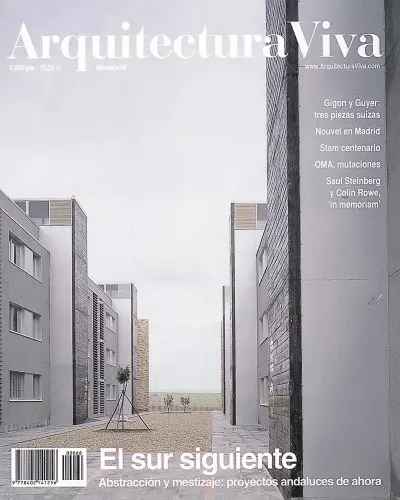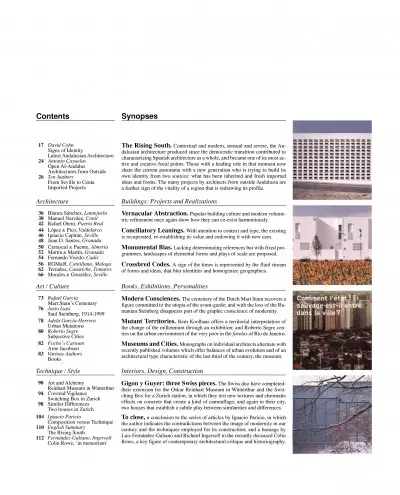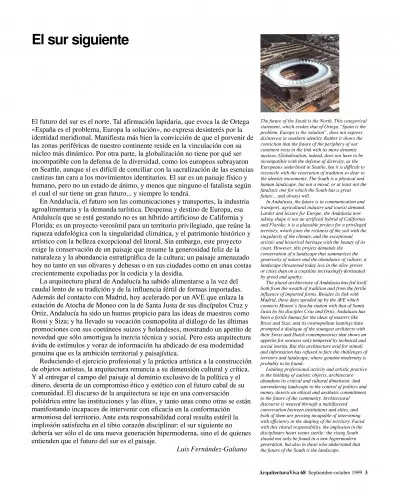Synopses
The Rising South. Contextual and modern, sensual and severe, the Andalusian architecture produced since the democratic transition contributed to characterizing Spanish architecture as a whole, and became one of its most active and creative focal points. Those with a leading role in that moment now share the current panorama with a new generation who is trying to build its own identity from two sources: what has been inherited and fresh imported ideas and forms. The many projects by architects from outside Andalusia are a further sign of the vitality of a region that is redrawing its profile.
Contents
David Cohn
Signs of Identity
Latest Andalusian Architecture
Antonio Cayuelas
Open Al-Andalus
Architectures from Outside
Ten Authors
From Seville to Ceuta
Imported Projects
Buildings: Projects and Realizations
Vernacular Abstraction. Popular building culture and modern volumetric refinement once again show how they can co-exist harmoniously. Architecture
Blanca Sánchez, Lantejuela
Manuel Narváez, Conil
Rafael Otero, Puerto Real Conciliatory Leanings. With attention to context and type, the existing is recuperated, re-establishing its value and endowing it with new uses. López y Pico, Valdelarco
Ignacio Capitán, Seville
Juan D. Santos, Granada Monumental Bias. Lacking determinating references but with fixed programmes, landscapes of elemental forms and plays of scale are proposed.
Carrascal y Puente, Almería
Martín y Martín, Granada
Fernando Visedo, CádizCrossbred Codes. A sign of the times is represented by the fluid stream of forms and ideas, that blur identities and homogenize geographies. RGM&R, Cantillana, Málaga
Terrados, Casariche, Tomares
Morales y González, Seville
Books, Exhibitions, Personalities
Modern Consciences. The centenary of the Dutch Mart Stam recovers a figure committed to the utopia of the avant-garde; and with the loss of the Rumanian Steinberg disappears part of the graphic conscience of modernity. Art / Culture
Rafael García
Mart Stam’s Centenary
Justo Isasi
Saul Steinberg, 1914-1999Mutant Territories. Rem Koolhaas offers a territorial interpretation of the change of the millennium through an exhibition; and Roberto Segre centres on the urban environment of the very poor in the favelas of Rio de Janeiro. Adela García-Herrera
Urban Mutations
Roberto Segre
Subjective CitiesMuseums and Cities. Monographs on individual architects alternate with recently published volumes which offer balances of urban evolution and of an architectural type characteristic of the last third of the century, the museum.
Focho’s Cartoon
Arne Jacobsen
Various Authors
Books
Interiors, Design, Construction
Gigon and Guyer: three Swiss pieces. The Swiss duo have completed their extension for the Oskar Reinhart Museum in Winterthur and the Switching Box for a Zurich station, in which they test new textures and chromatic effects on concrete that create a kind of camouflage; and again in their city, two houses that establish a subtle play between similarities and differences. Technique / Style
Art and Alchemy
Reinhart Museum in Winterthur
Covered Vigilance
Switching Box in Zurich
Similar Differences
Two houses in ZurichTo close, a conclusion to the series of articles by lgnacio Paricio, in which the author indicates the contradictions between the image of modernity in our century and the techniques employed for its construction; and a homage by Luis Fernández-Galiano and Richard Ingersoll to the recently deceased Colin Rowe, a key figure of contemporary architectural critique and historiography. Ignacio Paricio
Composition versus Technique
English Summary
The Rising South
Fernández-Galiano, Ingersoll
Colin Rowe, 'in memoriam'
Luis Fernández-Galiano
The Rising South
The future of the South is the North. This categorical statement, which evokes that of Ortega “Spain is the problem, Europe is the solution”, does not express disinterest in southern identity. Rather it shows the conviction that the future of the periphery of our continent rests in the link with its more dynamic nucleus. Globalization, indeed, does not have to be incompatible with the defense of diversity, as the Europeans underlined in Seattle, but it is difficult to reconcile with the veneration of tradition so dear to the identity movements. The South is a physical and human landscape, but not a mood, or at least not the fatalistic one for which the South has a great future... and always will.
In Andalusia, the future is in communication and transport, agricultural industry and tourist demand. Larder and leisure for Europe, the Andalusia now taking shape is not an artificial hybrid of California and Florida; it is a plausible project for a privileged territory, which joins the richness of the soil with the singularity of the climate, and the exceptional artistic and historical heritage with the beauty of its coast. However, this project demands the conservation of a landscape that summarizes the generosity of nature and the abundance of culture; a landscape threatened today less in the olive groves or cities than on a coastline increasingly devastated by greed and apathy.
The plural architecture of Andalusia has fed itself both from the wealth of tradition and from the fertile influence of imported forms. Besides its link with Madrid, these days speeded up by the AVE which connects Moneo’s Atocha station with that of Santa Justa by his disciples Cruz and Ortiz, Andalusia has been a fertile humus for the ideas of masters like Rossi and Siza; and its cosmopolitan leanings have prompted a dialogue of the youngest architects with their Swiss and Dutch contemporaries that shows an appetite for newness only tempered by technical and social inertia. But this architecture avid for stimuli and information has refused to face the challenges of territory and landscape, where genuine modernity is probably to be found.
Limiting professional activity and artistic practice to the building of autistic objects, architecture abandons its critical and cultural dimension. And surrendering landscape to the control of politics and money, deserts an ethical and aesthetic commitment to the future of the community. Architectural discourse is weaved through a multifaceted conversation between institutions and elites, and both of them are proving incapable of intervening with efficiency in the shaping of the territory. Faced with this choral responsibility, the implosion in the disciplinary heart seems sterile: the rising South should not only be found in a new hypermodern generation, but also in those who understand that the future of the South is the landscape.








